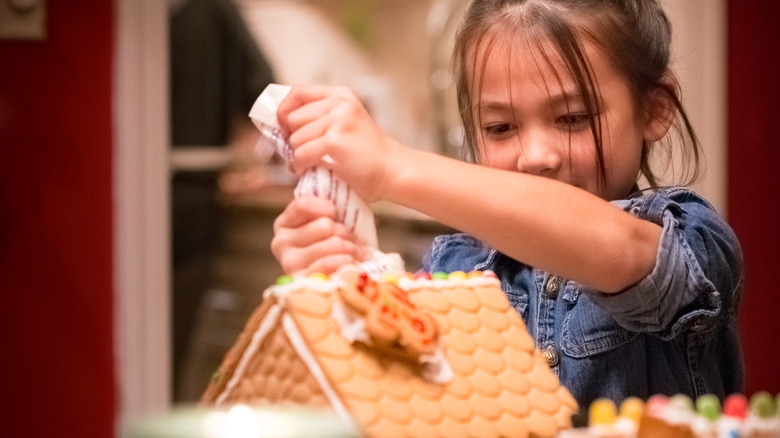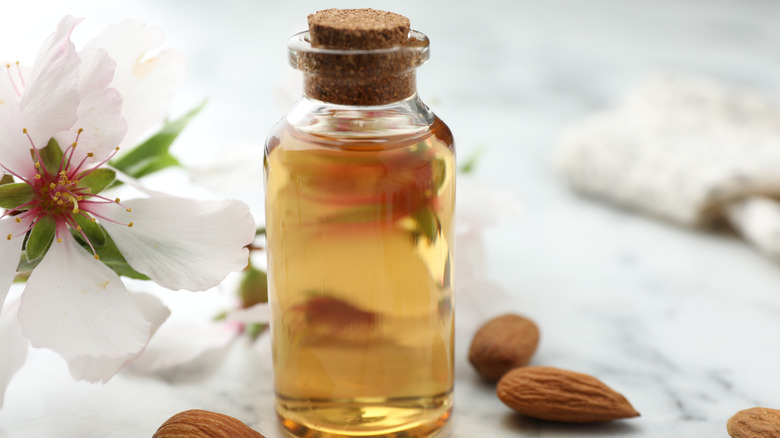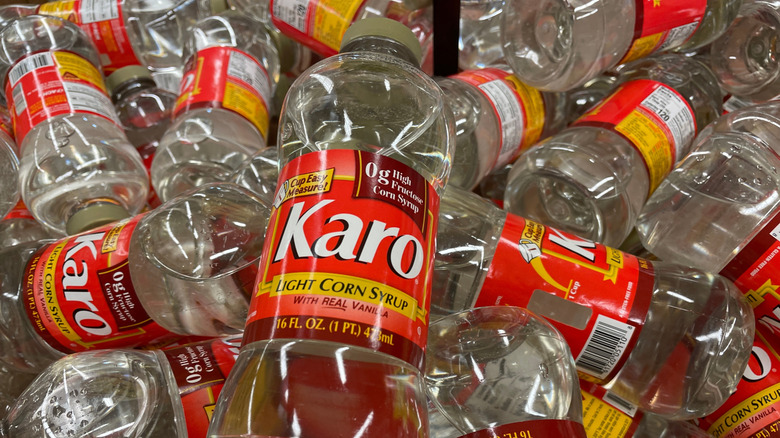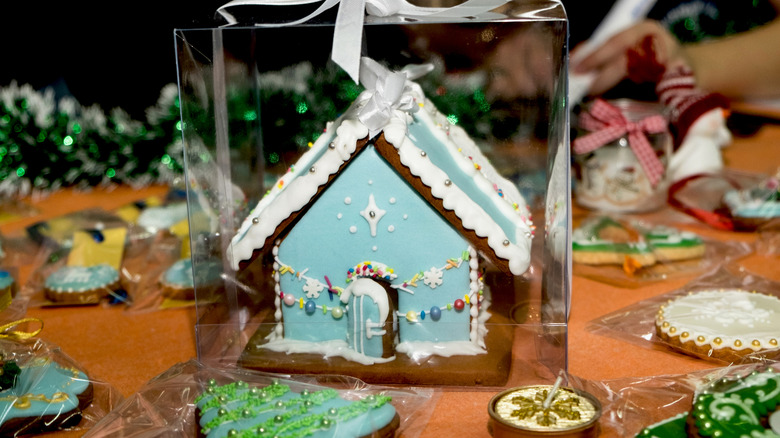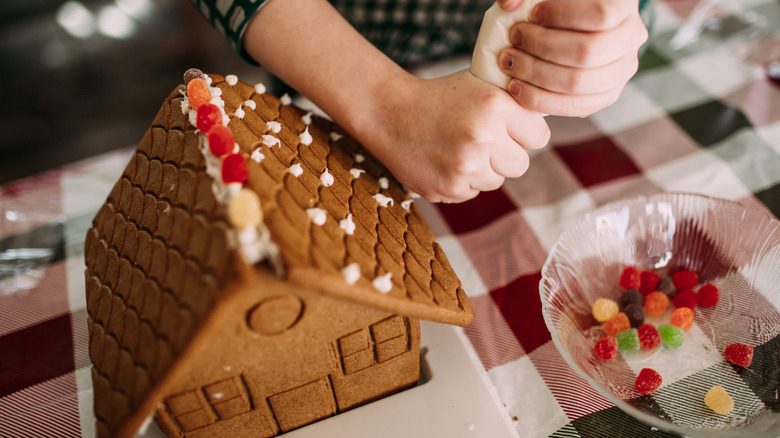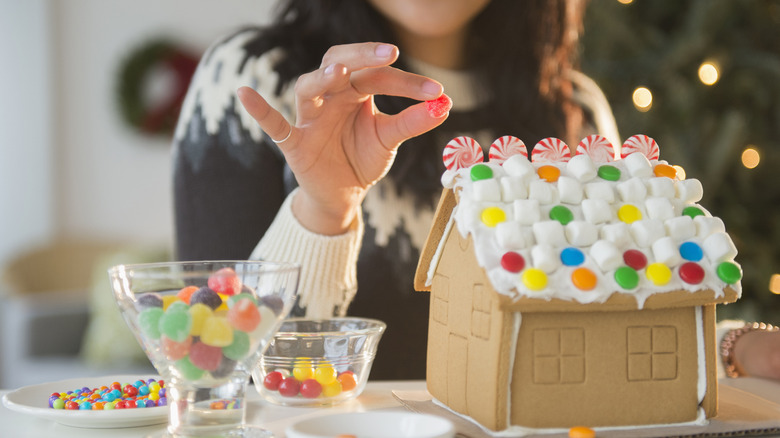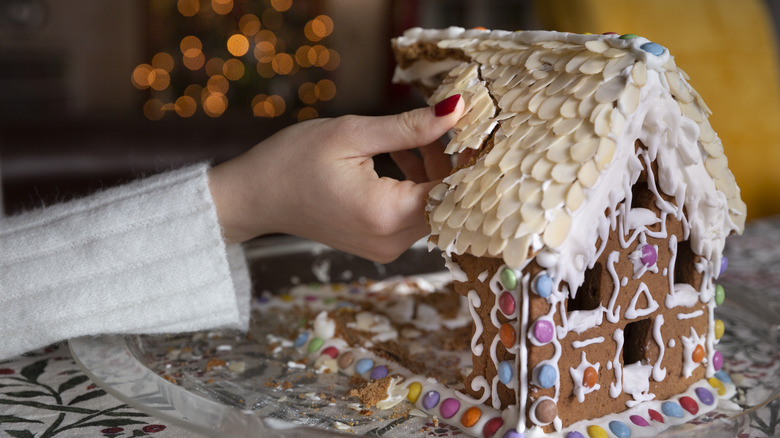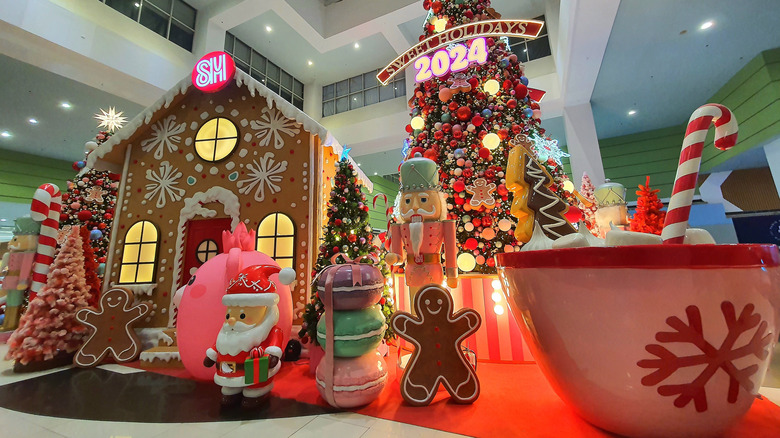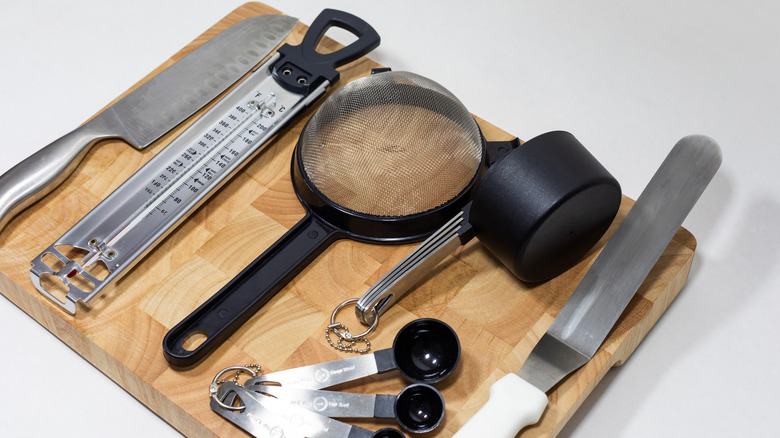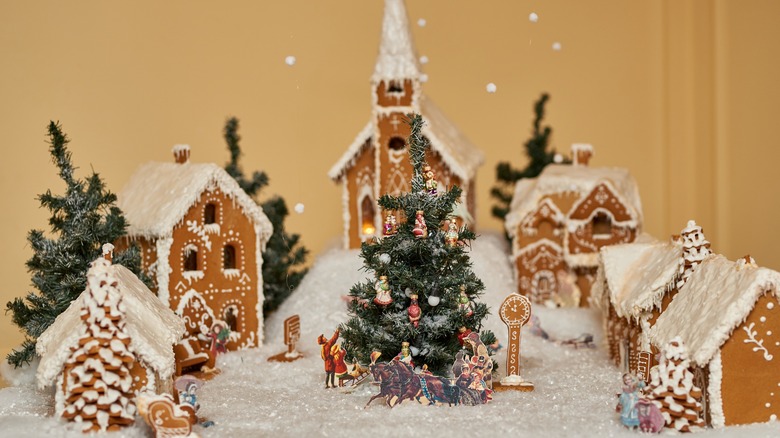14 Pro Tips To Make And Decorate The Best Gingerbread House
We may receive a commission on purchases made from links.
There's a lot to love about the holiday season. Our favorite part about this time of the year comes in two categories: things you can eat (like peppermint candies and seasonal chocolates) and things you can look at, including light displays and decorations. And then there is one thing that is right smack in the middle of the two of them: gingerbread houses. These edible, festive displays are an essential part of the holiday season for many, as there is some whimsical, childlike joy in baking copious batches of gingerbread cookies, trying to neatly pipe icing onto them, and decorating with whatever sugary finds you can source from your local grocery store.
Anyone that has ever made a gingerbread house will tell you that it's harder than it looks. It's almost like you need a PhD in engineering (not to mention in pastry arts) to properly assemble your gingerbread house — let alone decorate it. Luckily, we chatted with an expert in gingerbread making and assembly, pastry chef Nicole Salazar, to get some insight into how to make beautiful gingerbread houses. She's even putting her gingerbread skills to the test to construct a massive display for Pebble Beach Resorts at The Inn at Spanish Bay. Salazar shared tips for mastering all aspects of gingerbread, from the baking to the finishing decorative touches, with us. Hopefully, you can employ some of these techniques to make your seasonal gingerbread house as festive (and as structurally sound) as it can be.
Use royal icing for assembling your gingerbread house
There are a lot of different types of frosting out there. From tasty, sweet buttercreams to fluffy whipped cream, it can be hard to select a single frosting to use for your recipe. But when it comes to making gingerbread houses, there is one right answer: royal icing. According to pastry chef Nicole Salazar, royal icing is an essential for decorating your gingerbread house. "Royal icing dries rock hard and is easy to manipulate structurally," she explains. If you were to substitute this icing with something like fluffy buttercream, you would have to sacrifice structural stability.
But, it's not like you have to settle for unsatisfying royal icing. If you want to make a royal icing that's easy to work with, Salazar recommends trying to whip air into it "as long as possible" so that it takes on a fluffy consistency. This will allows you to easily pipe buttercream-like designs on to the cookies, rather than having it come out as a single, sad line.
Experiment with different extracts to flavor your icing
Royal icing tends to take on one single flavor: sweet. There's often no dimension to it, which can feel and taste a big dissatisfying. But, one of the ingredients that Nicole Salazar uses to add depth to her royal icing is almond extract. Almond extract has a very potent flavor, which means that you only need to add a little bit to your icing to really get the flavor that you're after.
There are also other types of extracts out there that are worth using. Vanilla is a simple one that will add some sophistication and flavor to your recipe, while orange extract (just a little bit, as this is also super potent) will contrast the spices in your gingerbread quite well. If you want to balance out the flavors, your instinct might be to lessen the amount of sugar in your royal icing recipe, but this is a bad idea. The chemical relationship between the sugar, egg whites (or meringue powder), and liquid is the reason why it's super strong and easy to pipe; messing with the recipe may lead to a structural disaster.
Add corn syrup to your gingerbread to make it easier to work with
While a big part of making a gingerbread house is about the decorations, it's also all about the bake, too. There are tons of ingredients you can use to upgrade your gingerbread, but one of the most structurally significant of them is corn syrup. It's often sold by brands like Karo and comes in two different forms: light and dark. The sticky, sweet consistency of this ingredient makes it one that you may want to consider adding to your gingerbread house dough. "Corn syrup helps the gingerbread have a structurally hard texture [that's] perfect for assembly," says Nicole Salazar.
When you're making gingerbread for a house or a holiday display, the goal is not to include ingredients that would cause it to steam and puff up. Ingredients like eggs and milk can lead to this, which is why many gingerbread recipes will skip these classic cookie additions. Instead, the corn syrup is used to keep the dough moist and pliable, without contributing to any rise. This slight moisture content can also keep the dough easy to handle and to build with, in turn leading to an easy construction.
Cooking your gingerbread longer will prolong its life
How long does a gingerbread house last? Well, that kind of depends on what it's made of and how it's made. While most people only display their gingerbread houses for the holiday season, which lasts about eight weeks, other folks keep their gingerbread houses for up to a year. Clear, non-edible lacquer can also keep your gingerbread house looking good all season long — though, you'll need to resist the temptation to bite into it.
Another thing that will help your gingerbread house last as long as possible is if you bake your gingerbread longer than you would for a snappy or soft cookie. "The longer you cook the gingerbread, the more firm it will be, allowing the display to last longer," says Nicole Salazar. You'll want to keep an eye on your gingerbread as it's baking to ensure that you don't burn it to a crisp though. While many cookies won't bake more than 10 to 15 minutes, your gingerbread needs about 25 to 30 minutes in the oven to properly dry out before you can start building. "If your gingerbread isn't hard as a rock, then it isn't good gingerbread build material," says Salazar.
Piping bags are helpful, but not necessary
One of the reasons why people may not want to try constructing their own gingerbread house is because they don't feel comfortable piping. But lucky for those folks, Nicole Salazar says that a "ziplock bag with icing will do" when you don't have a piping bag and set of piping tips on hand. The benefit of using a piping bag with a coupler and tips is that you can easily swap out the tips while you're working with the icing. This limits the amount of mess and bags you'll need to go through. Salazar goes on to explain that a size 18 star tip can help you create the "perfect scalloped edge." If you're having trouble filling your bag, she recommends folding the bag into a size 10 can (or something that resembles this large aluminum can) and using it as a holder as you stuff your bag.
You don't have to just use tips for the icing, either. You can add details to your gingerbread pieces before you slide it in the oven, too. Grab a basketweave tip for a thatched roof or use a grass tip to pipe texture onto the walls.
Use Rice Krispies treats to add dimension and playful elements to your display
A gingerbread house is more than just the four cookie walls and the icing. If you want to add depth to your display and turn your gingerbread house into a gingerbread home, you're going to want to also whip up a batch of Rice Krispies treats, too. Nicole Salazar uses Rice Krispies treats to shape the hills on her gingerbread-scape because the cereal is "easy to reheat and mold as you build."
The key to using these treats in your display, she explains, is to make sure that you're using them before they fully set. While in a normal Rice Krispies treat recipe you'd want to combine all the components together in a tray and press everything down well, Salazar says that the mix still needs to be hot (though obviously not burn-your-fingertips-hot) and malleable — so you won't need to press it into anything. She also notes that you don't need to add butter to your recipe; just some mini marshmallows and your favorite Rice Krispies cereal will do.
Use cookies and crackers for roofing materials
There are ton of ways to add texture to your gingerbread house design — and you may just need to take a spin down the cookie and cracker aisle at your local grocery store to find some inspiration. Nicole Salazar recommends using an array of different cookies, crackers, cereals, and nuts to add texture to your roof and give it a lifelike look. Not to mention, using a building material takes the pressure off of you to pipe yet another intricate design.
If you don't mind a menial task, for example, you may want to consider using slivered almonds for your gingerbread roof. Simply add a layer of royal icing and methodically place your slivered almonds down so it looks like a shingled roof. Cinnamon Toast Crunch cereal pieces can also offer this effect; the glistening sugar and cinnamon on the outside of the cereal pieces can really elevate your gingerbread house and make it resemble a real house.
Make sure your cookies are cool before assembling your display
The golden rule of baking (and decorating) anything is to always make sure that your temperatures are perfect. If you're working with warm gingerbread, you may find it to be more difficult to construct. The heat will radiate off the cookie walls and cause the icing to droop and melt, which will make the pieces harder to weld together. Not to mention, a house with candy gumdrops falling off the roof is probably an OSHA violation waiting to happen.
In order to make sure that your royal icing adheres to the gingerbread structure, Nicole Salazar recommends letting your gingerbread bases cool for at least three hours, though she shares that you can shave time off of this by putting the cookies into the freezer after you take them out of the oven. If you're not in a rush to construct your house, be sure to place it on a wire cooling rack so that air can circulate underneath and all sides of the gingerbread to cool it off effectively.
Fondant is your friend
Hey you, meet fondant — it's your best friend for decorating gingerbread houses. Nicole Salazar recommends using fondant instead of modeling chocolate for your gingerbread display, as the latter is a bit too brittle to shape into different things. "Fondant is my favorite medium ... as it is easy to use, especially if you warm it up in the microwave for 10 seconds," says Salazar. This short trip in the microwave will ensure that your fondant is pliable, so you can easily shape it into fun designs, cover your Rice Krispies treat hills with a layer of green, or add some decorative pizzazz to your gingerbread scene.
The biggest gripe that folks have with fondant, however, is that it doesn't exactly taste great. However, you can try your hand at a simple shortcut fondant recipe, made with only confectioner's sugar, mini marshmallows, and food coloring, and add a bit of your favorite extract to give it some flavor. Or, of course, just stick to using it for decorative purposes only.
Look in the candy aisle for decorating inspiration
The candy aisle should be another stop that you make before you head home to bake your gingerbread. These confections all offer a bright boost of color that will make your house look like it deserves a spot in Candyland.
For one, you might want to consider stocking up on candy-coated sunflower seeds; Nicole Salazar uses these to make realistic, colorful lightbulbs. Or, you may want to consider lining the outside of your house with Hershey's Kisses and M&M's, or try to create a little wintertime log pile using cut-up Twix or Kit Kat bars. While these candies may give you a sugar rush, they are relatively easy to stick to the royal icing and adorn any gingerbread scene with.
Consider the ambient conditions when picking decorations
While it might be snowy and wintry wherever you imagine your gingerbread house is, the conditions outside of your actual window may be anything but seasonal. Before you construct your gingerbread house, you need to pay attention to the ambient temperatures and humidity to ensure that your gingerbread house stays intact and that none of your components disintegrate. "Here in Monterey, California, we live in a very moist environment and sugar candies like Jolly Ranchers tend to melt easily within a day of sitting out," says Nicole Salazar. So, before you melt down those Jolly Ranchers to make a stained glass masterpiece, take a peek at the weather app on your phone.
There are some questions you should ask before you start thinking of things to put on your gingerbread house. The first being, "Does it melt?" Chocolate candies might get a little goopy if you have your fireplace going nearby, while hard candies like Tic Tacs and hard peppermints can withstand warmer temperatures.
LED lights can add brightness to your display
If you're willing to add a little bit of showy flair to your scene and are willing to compromise on something that's almost all edible, grab a string of lights. These will allow you to add a bit of life to your sugar windows and will really bring your entire "house" into fruition. Nicole Salazar recommends using LED lights for gingerbread displays, rather than incandescent bulbs, because the former won't cause any of the sugar work to melt. When you're ready to assemble, place a small section of battery operated lights into the center of your house and watch the whole thing light up like in "National Lampoon's Christmas Vacation." Though, if you don't want to burn through the battery, be sure to carefully place the battery pack outside of the house so that you can turn the lights on and off when you need to.
Another way to add a little bit of color and warmth to your decorations would be to use flame-shaped tea lights. Try placing it underneath a pile of Twix candies so that it resembles a warming fire, just waiting for some gingerbread people to come sit around it.
Kitchen tools can come in handy for finessing designs
You might think that all of the tools you need to make your gingerbread house are the mixing bowls, measuring spoons, sheets, and piping bags. But, if you want to give your gingerbread house an architect-level design, you're going to want to pull out all the stops. Nicole Salazar suggests grabbing a microplane zester and sandpaper to smooth the walls of your cookie layer, and you may even want to consider grabbing a pair of tweezers if you want to get real technical with the placement of those candies.
While these tools are really getting into the weeds of gingerbread house decorating, there are also tools that you can purchase that will make your gingerbread baking experience even simpler. Pick up an engraved rolling pin and use it to add texture to the outside of your gingerbread before you slide them into the oven. You can also leave your ruler and kitchen knife where they are if you pick up a set of gingerbread house cookie cutters instead.
Turn to cotton candy to make snow on your display
What would your gingerbread scene be like without a little snow? Boring and unseasonal — that's for sure. There are several different ways that you can turn your gingerbread house into a winter wonderland.
If you're working in a dry environment, Nicole Salazar recommends using cotton candy — particularly some that's white in color, rather than pink or blue. But, in humid conditions, you may want to turn to donut sugar instead. "This ingredient does not melt and leaves a powdered fresh snow look," she says. This product is a mixture of cornstarch and confectioners' sugar, so it's easy to see how it will impart a wintry feeling to your scene.
You could also add more holiday decorations by dripping royal icing down the roof panels like icicles, or creating little piles of snow using shaved coconut. With just a few ingredients, you can have your gingerbread masterpiece looking like it came straight out of a Hallmark movie.

